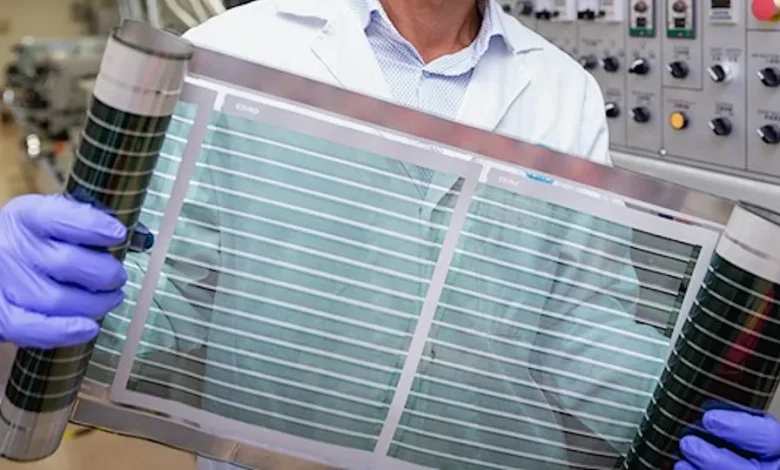CSIRO Scientists make headway with lightweight, printable solar sheets

Scientists at Australia’s Commonwealth Scientific and Industrial Research Organization (CSIRO) are doing their best impression of newspaper press room workers.
That’s because they are perfecting their technique to print thin, flexible solar cells with unique applications, including being put on buildings, vehicles, clothing, and wearable devices to provide sustainable power, according to a lab report from the Australian national science agency.
“It’s the best demonstration that this is a viable method of making the solar cells,” CSIRO renewable energy systems group leader Anthony Chesman told The Guardian.
A CSIRO photo of the material shows it looks like other versions being developed in labs elsewhere, resembling long strips of camera film coming off a printer.
The Australian experts said they are figuring out how to scale up production without sacrificing efficiency. To that end, a small version of the tech has an efficiency rate — how much sunlight is being converted to energy — close to that of standard solar panels.
Previous iterations of printed cells garnered only 1% or 2%, per the CSIRO report. MarketWatch notes that most panels have rates between 15% and 20%. The CSIRO team printed larger versions, at 7.75 square inches, with an 11% efficiency.
The accomplishment required rigorous analysis of the cells and of the printing process that allowed the team to quickly identify the ideal conditions for the setup to work.
“We developed a system for rapidly producing and testing over 10,000 solar cells a day — something that would have been impossible to do manually,” study lead author and CSIRO principal research scientist Doojin Vak said.
The printing process is made possible by perovskite, a group of crystal-like materials that are great at capturing sunpower, even when turned into an inky substance that can be run through the CSIRO press. Experts there say that printing ribbons of solar cells should be cheaper and more energy efficient than the method used to create typical silicon panels.
What’s more, the team replaced expensive gold and other metals in the ink with cheaper carbon, creating substantial savings.
Now the CSIRO team envisions printers churning out sun-catching ribbons that can power industry, energize disaster response efforts, and even provide electricity during space explorations.
Last year, solar projects accounted for three-quarters of the world’s renewable power additions, according to the International Energy Agency. Some concepts, such as one in China, use thousands of mirrors in a fascinating fashion inspired by ancient technology.
The printable cells could become a realistic, modern method for harnessing sunpower, even at home. With government funding and other incentives, homeowners who install solar can reduce or eliminate electric bills, saving more than $1,000 a year.
Further, about 8,500 pounds of pollution can be avoided. The result is healthier breathing, as dirty air has been associated with increased heart attack risk and diseases.
The CSIRO team closed the lab summary with a collaboration invitation to industry partners so it can bring the tech to market.
“We’re very interested in the niche applications we can move toward now,” Chesman said.
(Yahoo)





